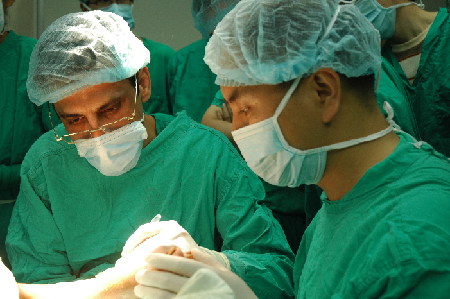The patients, still under anesthetic, had to be evacuated from the hospital building and into tents outside, where the medical staff calmly completed their operations.
"The patients were a bit taken aback when they came to. They had gone under anesthetic in the operating theater, and when they woke up they were in a tent!"
 Members of the British medical team performing an operation. Photo by Wang Pei.
Members of the British medical team performing an operation. Photo by Wang Pei.
As the Mianyang hospital building is now unsafe, the team has moved down to the Chengdu No. 2 People's Hospital.
Dr Redmond has over 20 years of active experience in the field – he has assisted after earthquakes in Armenia and Iran, dealt with the aftermath of volcanic eruption, and been involved in conflicts in Bosnia, Kosovo, and Serra Leone.
The Sichuan earthquake is the biggest he has seen. Specific features that he has noted include the wide geographical spread of damage and casualties, and the sequence of events – first the earthquake itself, then the aftershocks, and now the risk of further problems from flooding. The team was due to move further into the earthquake zone after their work in Mianyang, and the change of plan that brought them to Chengdu instead in the wake of the aftershock is typical of the flexibility required when trying to deal with this type of disaster.
This is Dr Redmond's first real visit to the Chinese mainland, although he came for a day several years ago during a trip to Hong Kong. He and the rest of the group have been touched by the reception they have been given.
"The whole team has been very impressed. People have been so welcoming, and grateful for our presence. There have been all sorts of small gestures, like taxi drivers refusing to let us pay our fares."
The team has particularly appreciated the level of cooperation that has been achieved with their Chinese counterparts. Surgical teams have worked together in joint operations – for example all the anesthesia services have been provided by local Chinese doctors.
As well as their medical work, there has been an encouraging level of engagement in related activities – academic exchanges, joint teaching, lectures, and conferences, which might provide a basis for more structured exchanges in the future.
A large number of patients of all ages from the original earthquake, as well as victims of Sunday's aftershock, have been treated. As might be expected, they show different types of injury. Survivors from the initial earthquake had injuries consistent, for example, with jumping from collapsed buildings, while injuries from the aftershock indicated blows from falling masonry, suggesting that victims may have been hurt trying to retrieve their belongings from dangerous buildings.